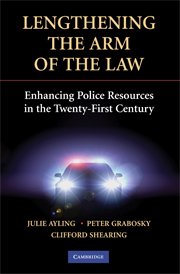2 - Obtaining and Allocating Police Resources
Published online by Cambridge University Press: 05 June 2012
Summary
INTRODUCTION
It will probably come as no surprise that public police budgets are not a common subject in the academic literature about policing. With a few exceptions, most policing scholars prefer to deal with policing objectives, methodologies and outcomes rather than come to grips with the more technical and undoubtedly drier subject of the financial underpinnings of police work. For many of us, budgets and accounts, with their long columns of figures and specialist language, are mystifying entities that we would prefer to remain the exclusive domain of accountants.
Police, however, have no choice but to grapple on a daily basis with issues concerning acquisition and allocation of resources. Not only must police get the job done, but they must be seen to be doing so in a way that is both efficient (not wasteful of resources) and effective (achieving desired outcomes). Political imperatives, such as the translation of private sector mentalities and methods into public sector activities over the last three or so decades, have driven changes in the way in which police strategize and implement resource decisions. Budgets for public policing are by all accounts getting tighter. Competition for security work is increasing, in the form of private security providers and volunteer organisations, while public demand for visible accessible public policing continues to grow. Police are facing the singular challenge of being required to function within a business paradigm while still trying to provide a ‘public service’ which delivers ‘justice’ and does so equitably and coherently.
- Type
- Chapter
- Information
- Lengthening the Arm of the LawEnhancing Police Resources in the Twenty-First Century, pp. 11 - 47Publisher: Cambridge University PressPrint publication year: 2008
- 1
- Cited by



